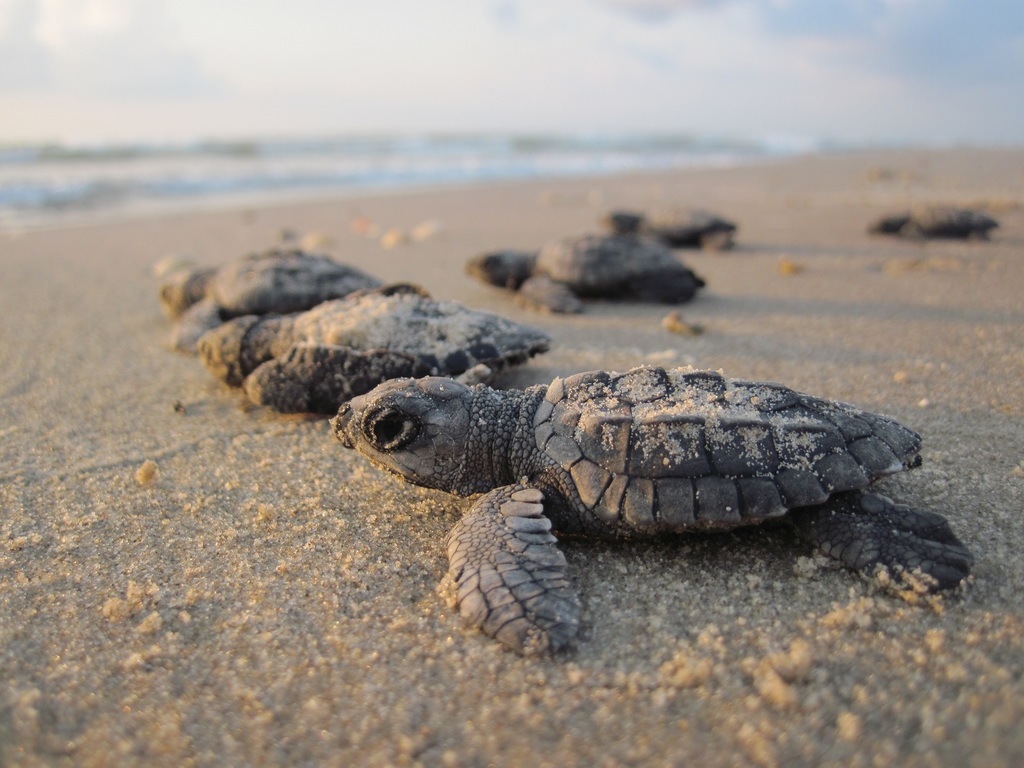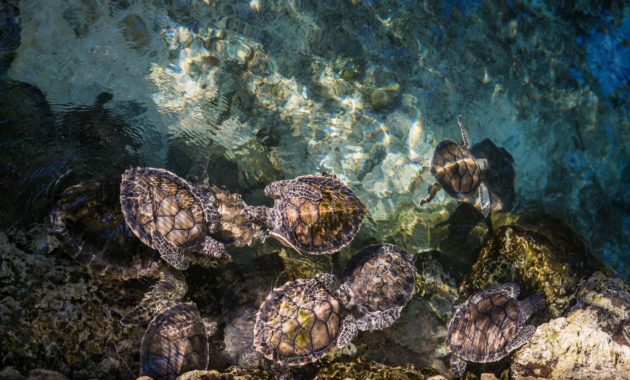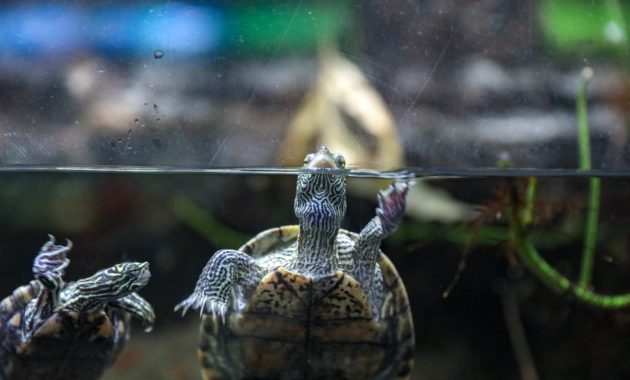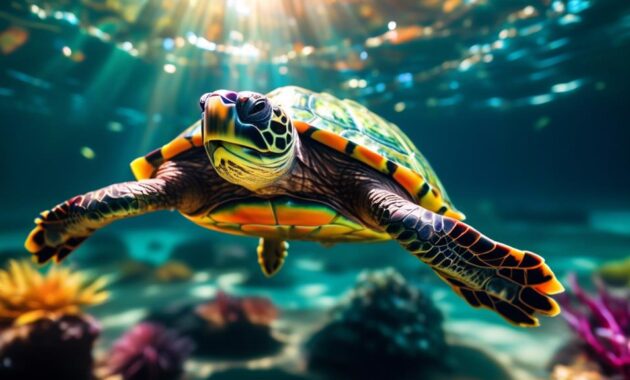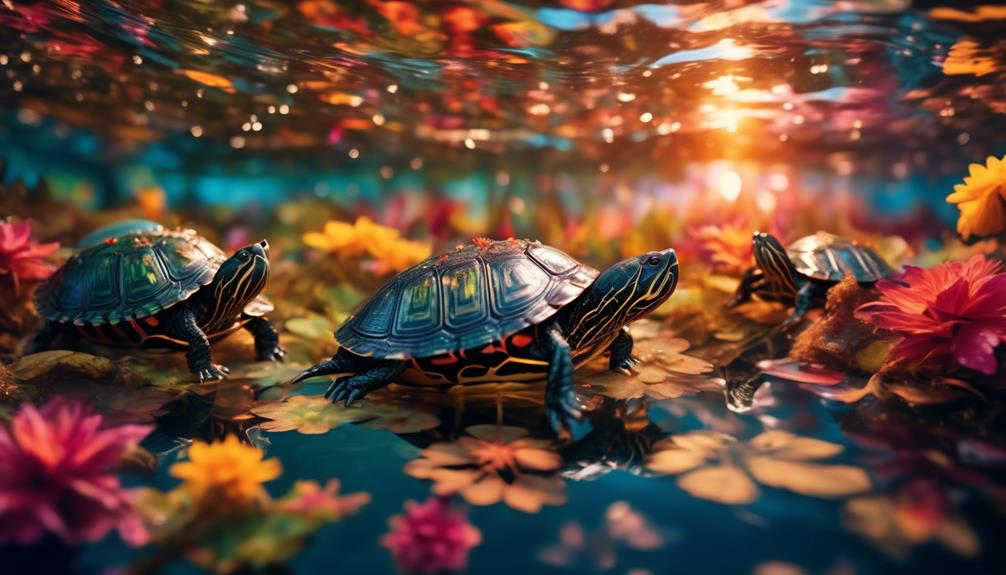
Are you ready to embark on an expedition through the vibrant and captivating world of Eastern Painted Turtles?
These remarkable creatures are like a living masterpiece, with their stunning colors and intricate patterns adorning their small, oval-shaped shells.
But there’s more to these turtles than meets the eye. From their fascinating diet to the careful environmental requirements they need to thrive, there’s a whole world of discovery awaiting you.
So, get ready to uncover the secrets and unravel the mysteries of the colorful world of Eastern Painted Turtles.
Key Takeaways
- Eastern Painted Turtles have a distinct appearance with a range of colors and markings on their carapace and skin.
- They prefer permanent ponds as their habitat and are attracted to farm ponds and beaver ponds.
- Proper care includes providing a large tank with the right water depth, basking spots, hiding spots, and a natural environment.
- Eastern Painted Turtles have a long lifespan of 25-50 years and require a varied diet for proper growth and development.
Eastern Painted Turtle Size
Eastern Painted Turtles vary in size, but they’re generally small turtles with an oval, keelless, and flattened carapace. These colorful creatures are known for their small stature, making them a popular choice for turtle enthusiasts.
As semi-aquatic turtles, they thrive in various habitats, from permanent ponds to slow-moving areas of rivers. When it comes to tank requirements, juvenile turtles need at least 10 gallons of water volume, along with a solid platform or sloping log for basking. It’s important to maintain proper water depth, which should be at least twice the width of their shell.
Additionally, providing hiding spots and non-toxic live plants in the tank will help create a comfortable environment for these fascinating turtles.
Type of Eastern Painted Turtle
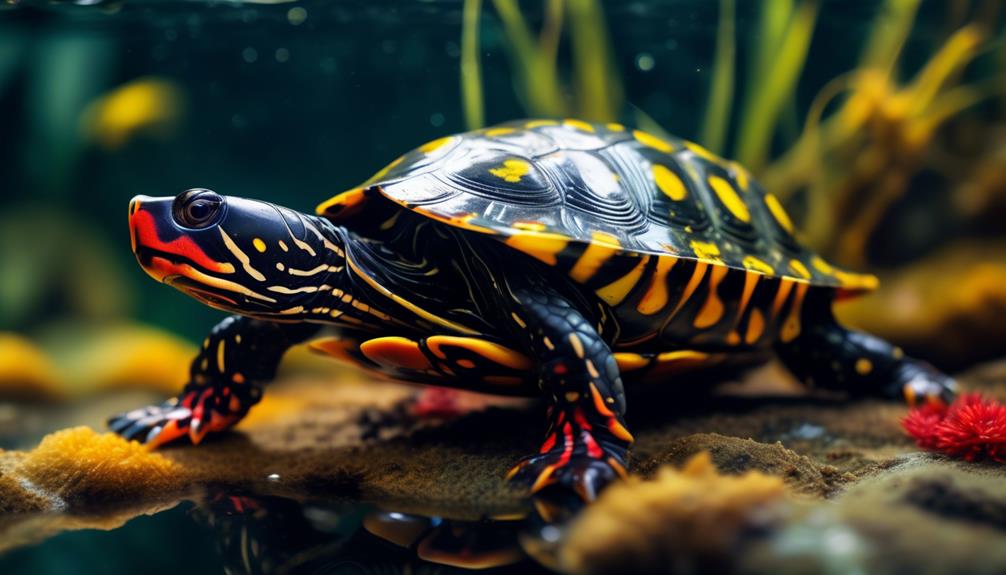
When considering the different types of Eastern Painted Turtles, it’s important to understand their unique characteristics and distinguishing features.
The Eastern Painted Turtle, also known as Chrysemys picta picta, is the top breed among the Eastern Painted Turtles. They’ve an oval, keelless, flattened, and smooth carapace. The carapace color ranges from olive to black with red or yellow borders and markings. Their skin color is black to olive with yellow or red stripes on their legs, tail, neck, and head.
Juvenile turtles have a rounder carapace until they’re two years old. Eastern Painted Turtles are native to environments from Maine to North Carolina, and occasionally in South Carolina and Georgia. They prefer permanent ponds, farm ponds, and beaver ponds, and can sometimes be found in slow-moving areas of rivers.
Lifespan of Eastern Painted Turtles
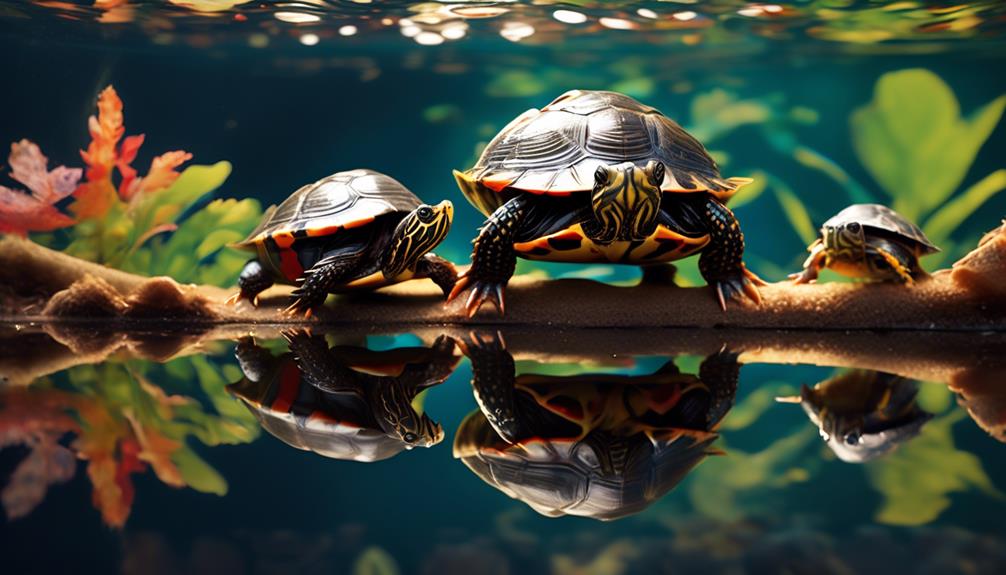
As we explore the lifespan of Eastern Painted Turtles, it is important to understand how long these captivating creatures can thrive in their natural habitats. Eastern Painted Turtles have a lifespan ranging from 25 to 50 years, making them long-lived companions. To provide a visual representation of their lifespan, here is a table showcasing the average lifespan of Eastern Painted Turtles in comparison to other popular turtle breeds:
| Turtle Breed | Lifespan (years) |
|---|---|
| Eastern Painted Turtle | 25-50 |
| Midland Painted Turtle | 30-40 |
| Western Painted Turtle | 20-30 |
This table illustrates the Eastern Painted Turtle’s impressive longevity, solidifying their status as one of the top breeds in the turtle world. With proper care and a suitable environment, you can enjoy the company of these colorful creatures for many years to come.
Eastern Painted Turtle Diet
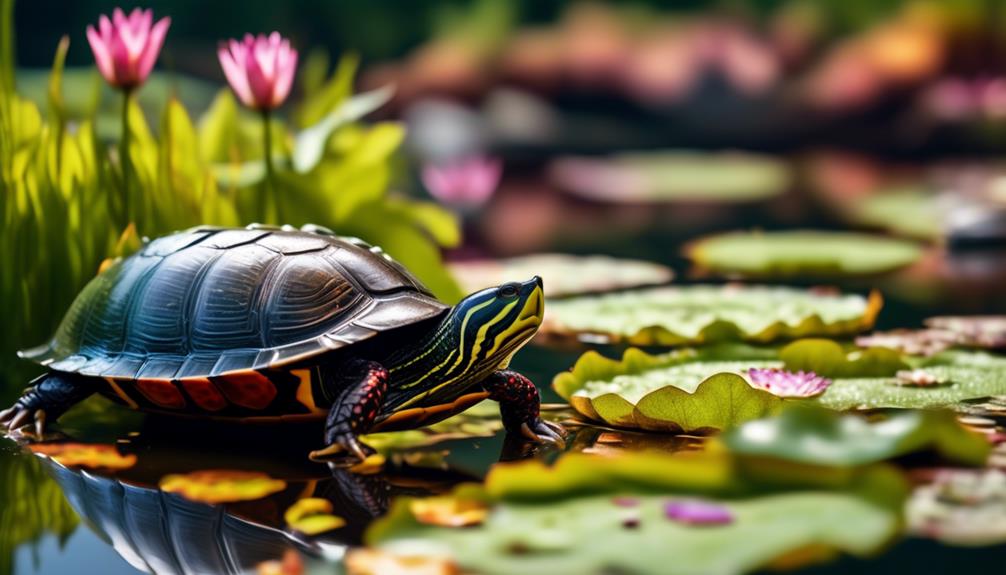
To ensure the health and well-being of your Eastern Painted Turtle, it’s essential to understand their dietary needs. Eastern Painted Turtles have a varied diet that consists of both plants and animals. A good portion of their diet can be made up of pelleted commercial turtle food, which provides them with essential nutrients.
Additionally, they enjoy eating fish, non-toxic aquatic plants, worms, insects, and green leafy vegetables. It’s important to offer a balanced diet to your turtle to promote proper growth and development. Providing a variety of foods will also keep them interested and satisfied.
Remember to feed them in appropriate amounts and monitor their weight to prevent overfeeding or malnutrition. By meeting their dietary needs, you can ensure that your Eastern Painted Turtle stays healthy and happy.
Care Difficulty of Eastern Painted Turtles
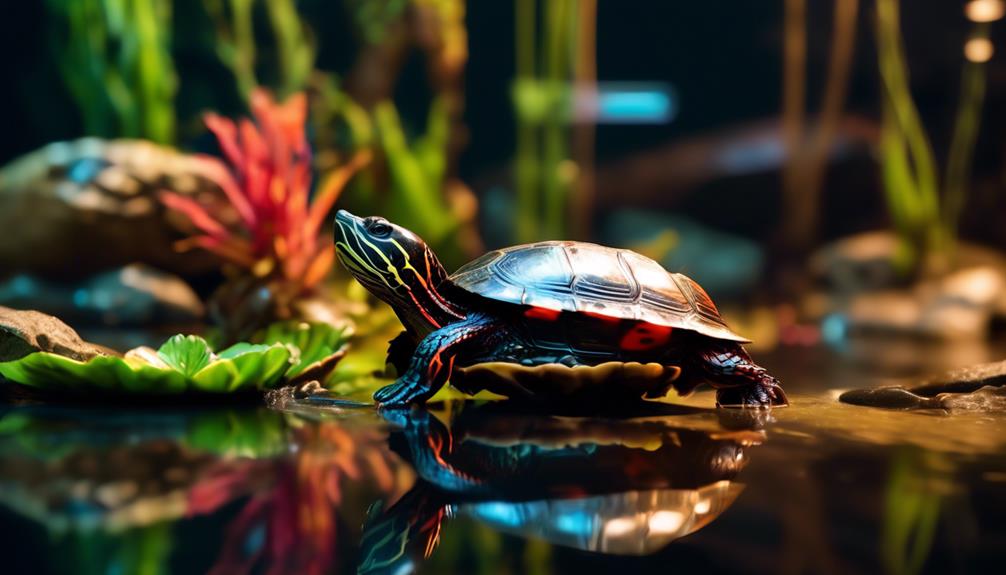
Now let’s shift our focus to the care difficulty of Eastern Painted Turtles, ensuring that you have all the necessary information to properly care for these fascinating creatures.
The care difficulty of Eastern Painted Turtles is considered to be low maintenance. They require a large tank with at least 10 gallons of water volume for juvenile turtles, along with a solid platform or sloping log for basking. The water depth should be at least twice the width of the shell.
It’s important to provide hiding spots and non-toxic live plants in the tank. Additionally, UVA/UVB light and temperature control are required.
Eastern Painted Turtles Vs Comparable Breeds
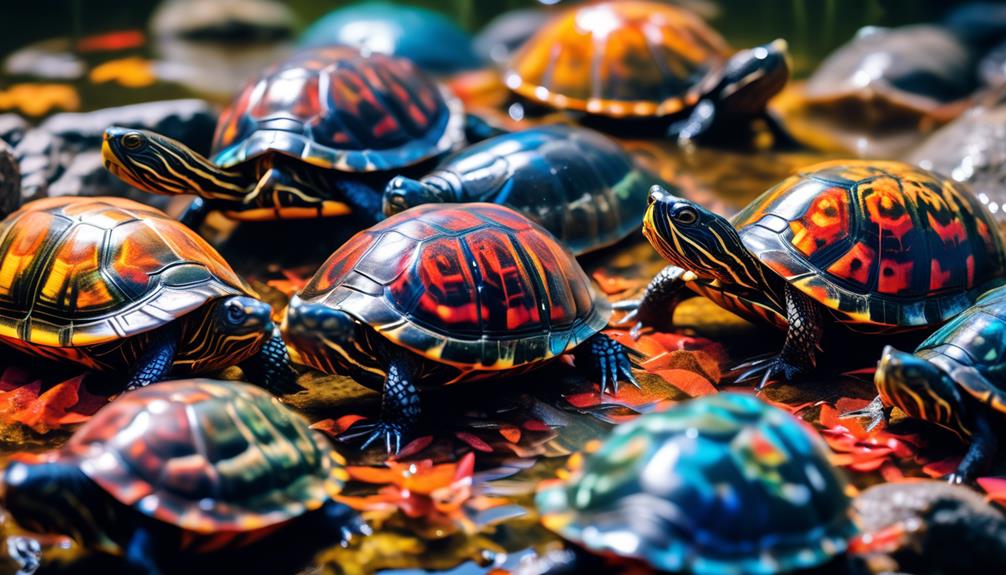
When comparing Eastern Painted Turtles to other breeds, the Eastern Painted Turtle stands out as the top choice.
Its vibrant carapace color, ranging from olive to black with red or yellow borders and markings, makes it visually striking.
The Eastern Painted Turtle also has a smooth and keelless carapace, along with a plastron that’s shorter than the carapace and without pattern.
In terms of care, these turtles require a large tank with at least 10 gallons of water volume for juveniles, along with a solid platform or sloping log for basking. They also need UVA/UVB light and temperature control.
Native Habitat of Eastern Painted Turtles
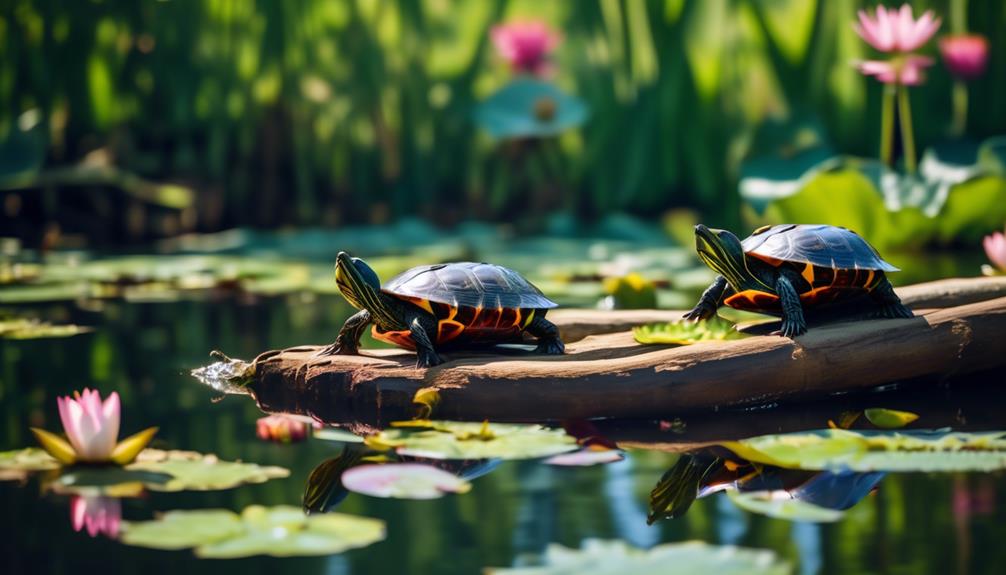
Eastern Painted Turtles thrive in a variety of habitats ranging from Maine to North Carolina, occasionally extending to South Carolina and Georgia. They have specific preferences when it comes to their native habitat:
- Preferred habitats:
- Permanent ponds: Eastern Painted Turtles prefer habitats with permanent ponds, as these provide a stable environment for them to thrive.
- Farm ponds and beaver ponds: These types of habitats also attract Eastern Painted Turtles due to the availability of food sources and shelter.
- Occasionally found in:
- Slow-moving areas of rivers: Eastern Painted Turtles can also be found in slow-moving areas of rivers, although this isn’t their preferred habitat.
These habitats provide the necessary conditions for Eastern Painted Turtles to find food, seek shelter, and reproduce. It’s important to provide a similar environment when keeping them in captivity to ensure their well-being.
Description of Eastern Painted Turtles
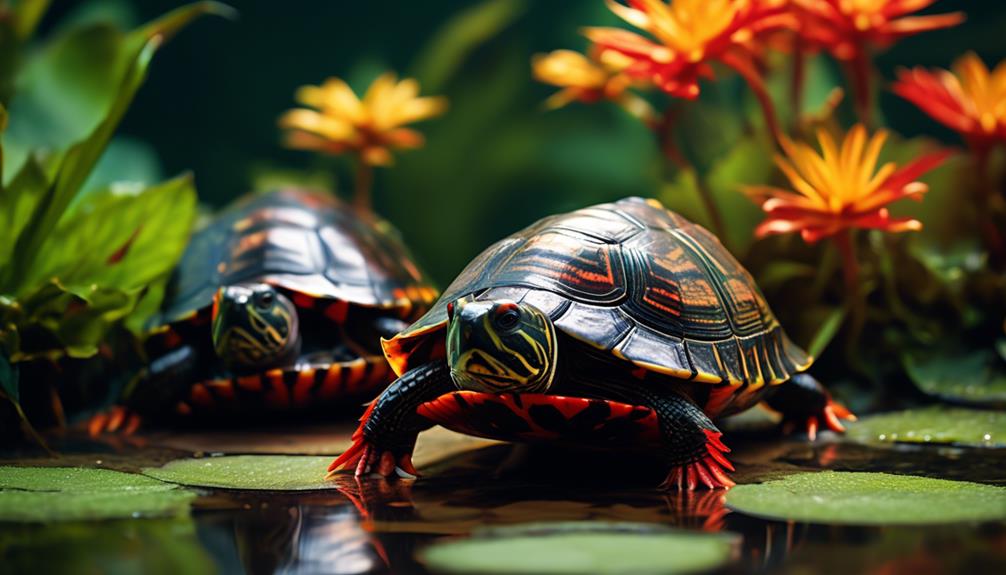
Eastern Painted Turtles showcase a variety of visually striking features that make them a captivating species to observe. These turtles have an oval, keelless, flattened, and smooth carapace, which can range in color from olive to black with red or yellow borders and markings. Their plastron is without pattern, hingeless, and shorter than the carapace.
As juveniles, their carapace is rounder until they reach about 2 years old. The skin of Eastern Painted Turtles is black to olive, with yellow or red stripes on their legs, tail, neck, and head. These vibrant colors make them stand out in their natural habitat.
With their unique appearance, Eastern Painted Turtles are truly a sight to behold.
Environmental Requirements for Eastern Painted Turtles
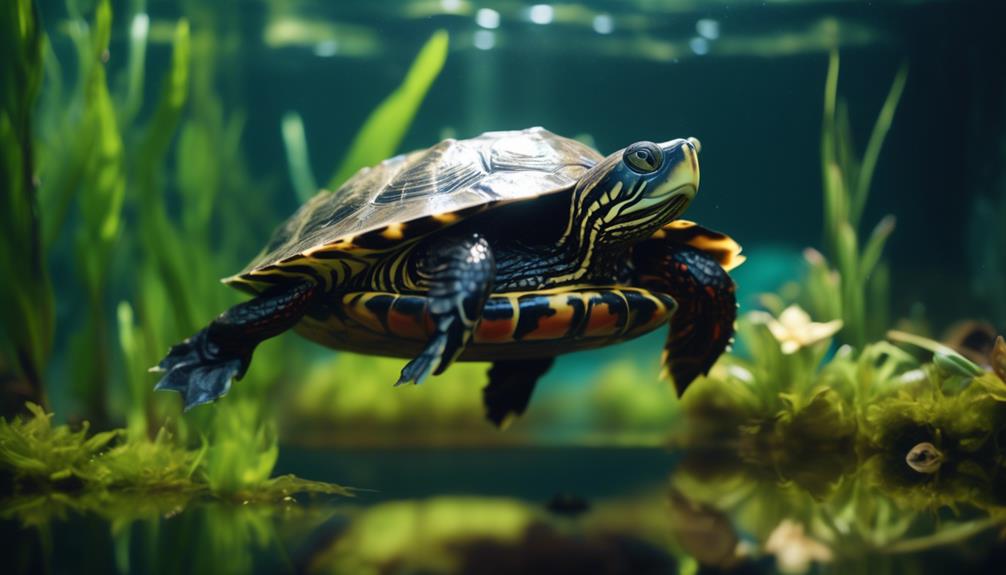
Now let’s explore the essential environmental requirements for keeping Eastern Painted Turtles in their optimal habitat. To ensure their well-being, you should consider the following:
- Tank Requirements
- Provide a large tank with a minimum water volume of 10 gallons for juvenile turtles.
- Include a solid platform or sloping log for basking.
- Water Conditions
- Maintain a water depth that’s at least twice the width of the turtle’s shell.
- Use hiding spots and non-toxic live plants to create a natural environment.
- Lighting and Temperature
- Install UVA/UVB lights to mimic natural sunlight and support their health.
- Control the temperature to provide a warm basking area and a cooler aquatic zone.
Tank Setup for Eastern Painted Turtles
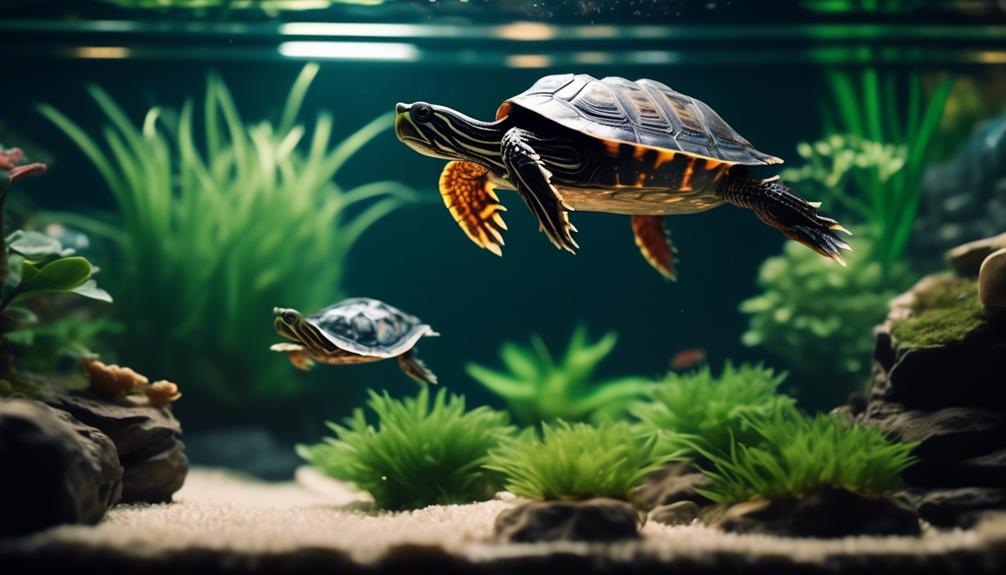
To properly set up a tank for Eastern Painted Turtles, consider the following guidelines.
- Provide a large tank with at least 10 gallons of water volume for juvenile turtles.
- Make sure to include a solid platform or sloping log for basking.
- The water depth should be at least twice the width of the shell.
- Use hiding spots and non-toxic live plants in the tank to create a natural environment.
- It’s important to have UVA/UVB light and temperature control to mimic their natural habitat.
- Remember to maintain water cleanliness by regularly cleaning the tank and providing a good filtration system.
Additional Information on Eastern Painted Turtles
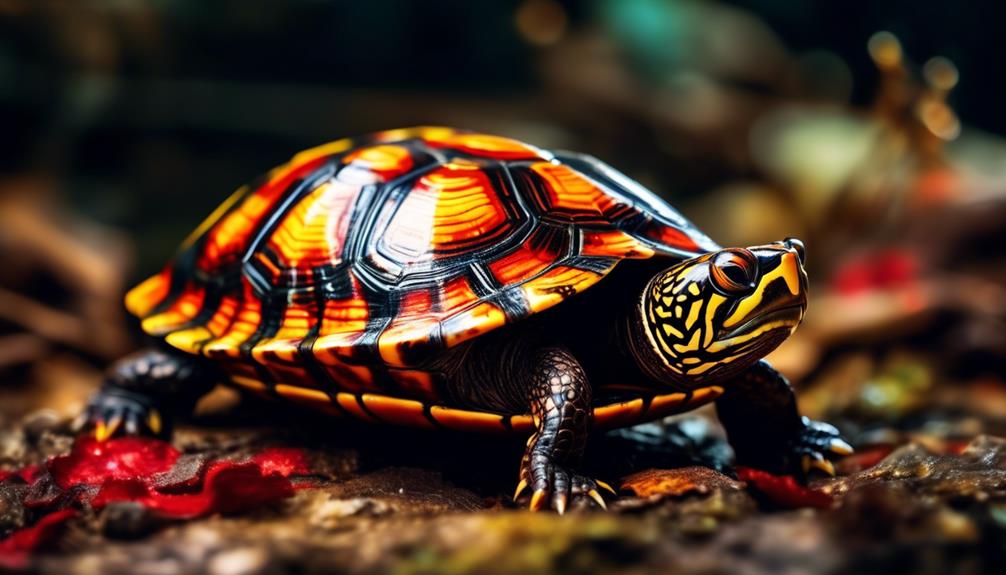
If you want to learn more about Eastern Painted Turtles, there are some interesting facts to discover. Here is some additional information about these colorful turtles:
- Reproduction:
- Females lay eggs in nests dug in sandy soil near water bodies.
- Clutch size can range from 2 to 20 eggs.
- Behavior:
- Eastern Painted Turtles are active during the day and are excellent swimmers.
- They’re known to bask in the sun to regulate their body temperature.
- Conservation Status:
- Eastern Painted Turtles are listed as a species of least concern by the International Union for Conservation of Nature (IUCN).
- However, habitat loss and pollution are potential threats to their populations.
These facts provide a deeper understanding of Eastern Painted Turtles and their unique characteristics and behaviors.
Frequently Asked Questions
What Are the Different Color Variations of Eastern Painted Turtles?
Eastern Painted Turtles come in a variety of colors. Their carapace can range from olive to black with red or yellow borders and markings. Their skin is black to olive with yellow or red stripes on their legs, tail, neck, and head.
Do Eastern Painted Turtles Require Any Specific Supplements in Their Diet?
Eastern painted turtles do not require specific supplements in their diet. They can be fed a variety of foods including pelleted turtle diet, fish, aquatic plants, worms, insects, and green leafy vegetables.
Can Eastern Painted Turtles Be Kept With Other Turtle Species in the Same Tank?
Yes, Eastern Painted Turtles can be kept with other turtle species in the same tank. However, it is important to ensure that the tank is large enough to accommodate multiple turtles and that they have enough hiding spots and resources.
Are Eastern Painted Turtles Known to Be Good Swimmers?
Yes, Eastern Painted Turtles are known to be good swimmers. They are a semi-aquatic turtle that prefers ponds and rivers. Their streamlined bodies and webbed feet make them adept at navigating through water.
How Often Should the Water in the Tank Be Changed for Eastern Painted Turtles?
You should change the water in the tank for your Eastern Painted Turtle regularly. It’s recommended to do a partial water change every week and a complete water change every month to maintain a clean and healthy environment for your turtle.
What are the Key Differences Between Eastern and Southern Painted Turtles?
The allure of southern painted turtle lies in its unique physical characteristics such as red or orange markings on its skin and yellow striping on its head, distinguishing it from the eastern painted turtle. Eastern painted turtles, on the other hand, have more varied shell markings and tend to be smaller in size.
Conclusion
So, if you’re ready to embark on an exciting journey into the vibrant world of Eastern Painted Turtles, make sure to provide them with a suitable habitat. This includes a large tank, ample water volume, and a solid basking platform.
Remember to also provide them with UVA/UVB light and temperature control for their optimal health.
With their captivating colors and unique characteristics, Eastern Painted Turtles are truly a fascinating species to explore and care for.
Dive in and enjoy the colorful world of these stunning creatures!

